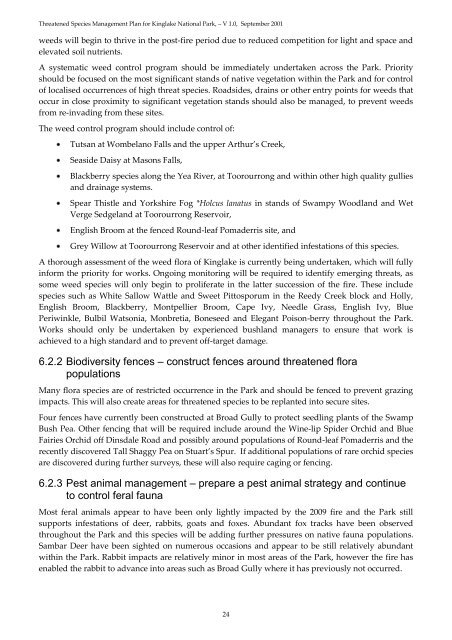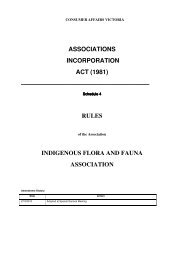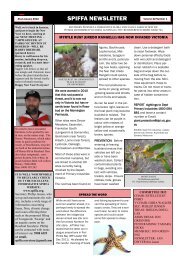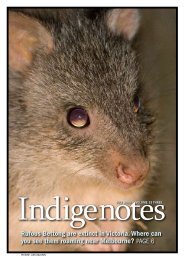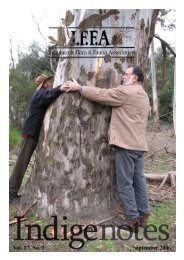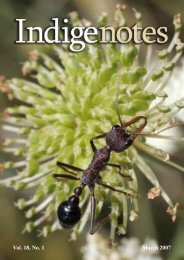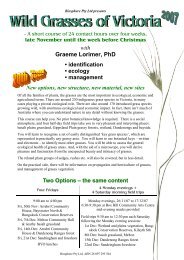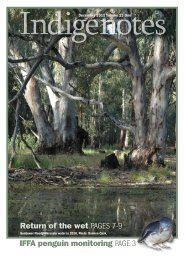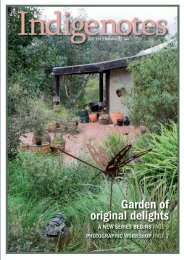Threatened Species Management Plan for Kinglake National Park
Threatened Species Management Plan for Kinglake National Park
Threatened Species Management Plan for Kinglake National Park
Create successful ePaper yourself
Turn your PDF publications into a flip-book with our unique Google optimized e-Paper software.
<strong>Threatened</strong> <strong>Species</strong> <strong>Management</strong> <strong>Plan</strong> <strong>for</strong> <strong>Kinglake</strong> <strong>National</strong> <strong>Park</strong>, – V 1.0, September 2001<br />
weeds will begin to thrive in the post-fire period due to reduced competition <strong>for</strong> light and space and<br />
elevated soil nutrients.<br />
A systematic weed control program should be immediately undertaken across the <strong>Park</strong>. Priority<br />
should be focused on the most significant stands of native vegetation within the <strong>Park</strong> and <strong>for</strong> control<br />
of localised occurrences of high threat species. Roadsides, drains or other entry points <strong>for</strong> weeds that<br />
occur in close proximity to significant vegetation stands should also be managed, to prevent weeds<br />
from re-invading from these sites.<br />
The weed control program should include control of:<br />
Tutsan at Wombelano Falls and the upper Arthur’s Creek,<br />
Seaside Daisy at Masons Falls,<br />
Blackberry species along the Yea River, at Toorourrong and within other high quality gullies<br />
and drainage systems.<br />
Spear Thistle and Yorkshire Fog *Holcus lanatus in stands of Swampy Woodland and Wet<br />
Verge Sedgeland at Toorourrong Reservoir,<br />
English Broom at the fenced Round-leaf Pomaderris site, and<br />
Grey Willow at Toorourrong Reservoir and at other identified infestations of this species.<br />
A thorough assessment of the weed flora of <strong>Kinglake</strong> is currently being undertaken, which will fully<br />
in<strong>for</strong>m the priority <strong>for</strong> works. Ongoing monitoring will be required to identify emerging threats, as<br />
some weed species will only begin to proliferate in the latter succession of the fire. These include<br />
species such as White Sallow Wattle and Sweet Pittosporum in the Reedy Creek block and Holly,<br />
English Broom, Blackberry, Montpellier Broom, Cape Ivy, Needle Grass, English Ivy, Blue<br />
Periwinkle, Bulbil Watsonia, Monbretia, Boneseed and Elegant Poison-berry throughout the <strong>Park</strong>.<br />
Works should only be undertaken by experienced bushland managers to ensure that work is<br />
achieved to a high standard and to prevent off-target damage.<br />
6.2.2 Biodiversity fences – construct fences around threatened flora<br />
populations<br />
Many flora species are of restricted occurrence in the <strong>Park</strong> and should be fenced to prevent grazing<br />
impacts. This will also create areas <strong>for</strong> threatened species to be replanted into secure sites.<br />
Four fences have currently been constructed at Broad Gully to protect seedling plants of the Swamp<br />
Bush Pea. Other fencing that will be required include around the Wine-lip Spider Orchid and Blue<br />
Fairies Orchid off Dinsdale Road and possibly around populations of Round-leaf Pomaderris and the<br />
recently discovered Tall Shaggy Pea on Stuart’s Spur. If additional populations of rare orchid species<br />
are discovered during further surveys, these will also require caging or fencing.<br />
6.2.3 Pest animal management – prepare a pest animal strategy and continue<br />
to control feral fauna<br />
Most feral animals appear to have been only lightly impacted by the 2009 fire and the <strong>Park</strong> still<br />
supports infestations of deer, rabbits, goats and foxes. Abundant fox tracks have been observed<br />
throughout the <strong>Park</strong> and this species will be adding further pressures on native fauna populations.<br />
Sambar Deer have been sighted on numerous occasions and appear to be still relatively abundant<br />
within the <strong>Park</strong>. Rabbit impacts are relatively minor in most areas of the <strong>Park</strong>, however the fire has<br />
enabled the rabbit to advance into areas such as Broad Gully where it has previously not occurred.<br />
24


